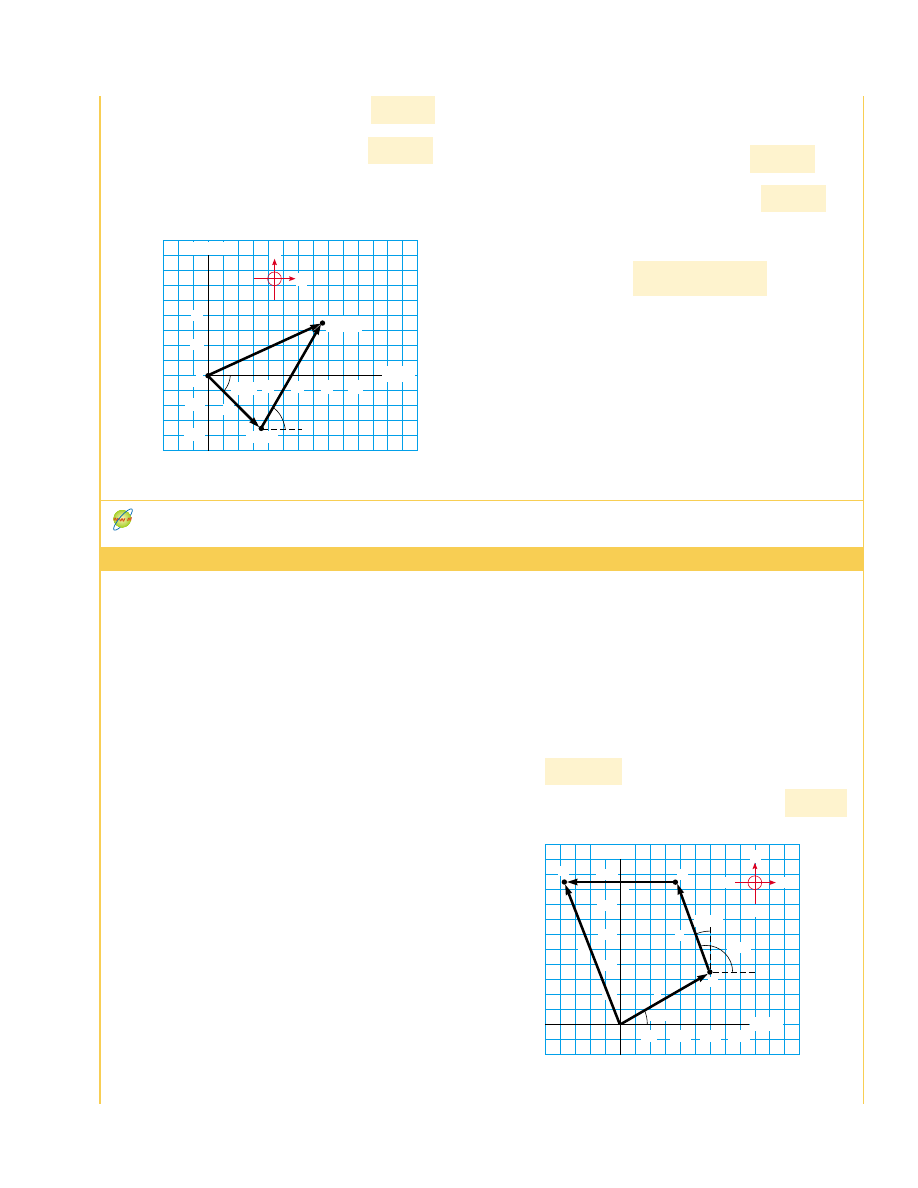Physics For Scientists And Engineers 6E - part 18

Finally, displacement
c, whose magnitude is 195 km, has the
components
c
x
"
c cos(180$) " (195 km)(# 1) " # 195 km
c
y
"
c sin(180$) " 0
Therefore, the components of the position vector
R from
the starting point to city C are
R
x
"
a
x
%
b
x
%
c
x
"
152 km # 52.3 km # 195 km
R
y
"
a
y
%
b
y
%
c
y
"
87.5 km % 144 km % 0 " 232 km
#
95.3 km
"
Solution The resultant displacement for the trip
R " A % B
has components given by Equation 3.15:
In unit–vector form, we can write the total displacement as
Using Equations 3.16 and 3.17, we find that the vector
R
has a magnitude of 41.3 km and is directed 24.1° north of
east.
Let us finalize. The units of
R are km, which is reason-
able for a displacement. Looking at the graphical represen-
tation in Figure 3.19, we estimate that the final position of
the hiker is at about (38 km, 17 km) which is consistent with
the components of
R in our final result. Also, both compo-
nents of
R are positive, putting the final position in the first
quadrant of the coordinate system, which is also consistent
with Figure 3.19.
(37.7ˆ
i % 16.9ˆj) km
R "
16.9 km
R
y
"
A
y
%
B
y
" #
17.7 km % 34.6 km "
37.7 km
R
x
"
A
x
%
B
x
"
17.7 km % 20.0 km "
SECTION 3.4 • Components of a Vector and Unit Vectors
69
Figure 3.19 (Example 3.5) The total displace-
ment of the hiker is the vector R " A % B.
y(km)
x(km)
60.0
°
B
45.0
° 20
30
40
50
Tower
R
Car
0
20
10
–10
–20
Tent
A
E
N
S
W
Example 3.6 Let’s Fly Away!
B
A
50
100 150 200
y(km)
150
250
200
100
50
110
°
20.0
°
30.0
°
c
b
a
R
C
x(km)
E
N
S
W
(B)
Determine the components of the hiker’s resultant dis-
placement
R for the trip. Find an expression for R in terms
of unit vectors.
34.6 km
B
y
"
B sin 60.0$ " (40.0 km)(0.866) "
20.0 km
B
x
"
B cos 60.0$ " (40.0 km)(0.500) "
A commuter airplane takes the route shown in Figure 3.20.
First, it flies from the origin of the coordinate system shown
to city A, located 175 km in a direction 30.0° north of east.
Next, it flies 153 km 20.0° west of north to city B. Finally, it
flies 195 km due west to city C. Find the location of city C
relative to the origin.
Solution Once again, a drawing such as Figure 3.20 allows us
to conceptualize the problem. It is convenient to choose the co-
ordinate system shown in Figure 3.20, where the x axis points
to the east and the y axis points to the north. Let us denote the
three consecutive displacements by the vectors
a, b, and c.
We can now categorize this problem as being similar to
Example 3.5 that we have already solved. There are two pri-
mary differences. First, we are adding three vectors instead
of two. Second, Example 3.5 guided us by first asking for the
components in part (A). The current Example has no such
guidance and simply asks for a result. We need to analyze the
situation and choose a path. We will follow the same pattern
that we did in Example 3.5, beginning with finding the com-
ponents of the three vectors
a, b, and c. Displacement a has
a magnitude of 175 km and the components
Displacement
b, whose magnitude is 153 km, has the com-
ponents
b
y
"
b sin(110$) " (153 km)(0.940) " 144 km
b
x
"
b cos(110$) " (153 km)(#0.342) " #52.3 km
a
y
"
a sin(30.0$) " (175 km)(0.500) " 87.5 km
a
x
"
a cos(30.0$) " (175 km)(0.866) " 152 km
Figure 3.20 (Example 3.6) The airplane starts
at the origin, flies first to city A, then to city B,
and finally to city C.
Investigate this situation at the Interactive Worked Example link at http://www.pse6.com.